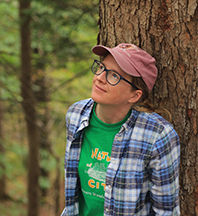Week of August 6, 2023 – August 12, 2023
by Anna Stunkel, Environmental Educator
On any summer day, you may come across a great variety of spiders. They crawl, pounce, spin silk, and sit in wait for their prey. Some have fuzzy bodies with a stout appearance, while others hang suspended from their webs on long, spindly legs. They often capture and consume insects that we consider to be pests.
While spiders often have an undeserved bad reputation as creepy crawlies, there are many opportunities to introduce visitors to their beauty here at Baltimore Woods. This past week, I led a group of preschoolers at camp, some of whom were wary of spiders. When I shared that spiders are a special part of nature, one child remarked, “but they bite!” That’s when I had a realization that I wanted to share with the campers, which helped them to feel less afraid. I told them, “I’ve let probably hundreds of spiders crawl on my hand (perhaps a slight exaggeration), and guess how many have bitten me? Zero!” They were rather surprised to hear that spiders usually do not bite unless they feel very threatened.
Of course, I don’t suggest that children go around letting just any spider crawl on their hand, especially in areas with more venomous species. And I’m also patient with those who experience arachnophobia; it’s ok to be unsure about spiders as long as you respect them! But sometimes we humans are too quick to judge other creatures, and we forget that they often use defenses like biting as a last resort. If you handle them with care and respect, they will usually just crawl gently over your hand and back into the leaf litter. By learning how to identify different species and being informed about their habits, people can feel safer about which spiders they might handle. In a recent camp session, we found an enormous fishing spider and decided it was best to give this spider space. She was carrying eggs which are fragile, and although fishing spiders are usually docile their bite can feel like a bee sting.
For those who would rather observe all spiders without handling them, it can be great fun to watch them spinning webs from a distance or to search for females carrying egg sacs through the grass. During a recent field sketching program, we found a huge grass spider carrying an egg sac and enjoyed drawing her as a group. Egg sacs usually look like miniature white golf balls bouncing along.
I’ve noticed that after talking about spiders in a positive way, children often become more interested in them and even make remarks like, “they’re so cute!” or marvel at their colors and patterns. Sharing the world of misunderstood creatures like spiders and snakes is one of my favorite ways to help people connect with nature. In the long run this benefits the creatures as well, so more people are around to care about keeping them and their homes safe.
I hope you enjoy looking for spiders crawling around and spinning webs this summer!


